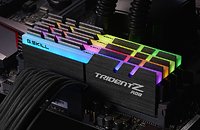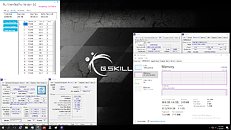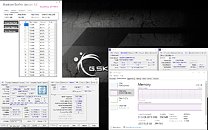Friday, November 24th 2017

G.SKILL Releases Ultra Low Latency CL17 Trident Z RGB DDR4-4266MHz Kits
G.SKILL International Enterprise Co., Ltd., the world's leading manufacturer of extreme performance memory and gaming peripherals, is thrilled to announce new ultra-low latency additions to the Trident Z RGB series memory kits, starting from DDR4-4000MHz CL17-17-17-37 up to DDR4-4266MHz CL17-18-18-38 32GB (4x8GB). This is the first time in tech history that DDR4 memory kits above DDR4-4000MHz speed is available at the low CL17 timing, and with lower timings, memory kits can utilize high frequency to its fullest potential with improved memory performance. To achieve the ultra-low latency of CL17, these new memory kits are made with rigorously hand-binned, high-performance Samsung B-die DDR4 IC components.
As the leading manufacturer of extreme performance memory, G.SKILL is always improving and reaching higher levels of performance than ever before. The fastest selection from the new Trident Z RGB lineup is available at DDR4-4266MHz CL17-18-18-38 32GB (4x8GB) at 1.45V. The following screenshot shows this new memory kit running on the ASUS ROG MAXIMUS X HERO motherboard with the Intel Core i7-8700K processor.Ultra-Efficient 17-17-17 CAS Latency
Following the DDR4-4266MHz kit, are memory kits running at DDR4-4000MHz and DDR4-4133MHz in both 16GB (2x8GB) and 32GB (4x8GB) configurations, all at an ultra-efficient CL17-17-17-37 timing. Below is a screenshot of Trident Z RGB running at DDR4-4133MHz CL17-17-17-37 32GB (4x8GB) on the ASUS ROG MAXIMUS X HERO motherboard with the Intel Core i7-8700K processor.
Detail Specifications
These high performance memory kits are outfitted with the latest Intel XMP 2.0 technology for easy memory overclocking. For a full list of available specifications and configurations, see the chart below for the full lineup that will join the G.SKILL Trident Z RGB family.Availability
These awesome new low latency Trident Z RGB memory kits will be available from authorized G.SKILL distribution partners starting in January 2018.
As the leading manufacturer of extreme performance memory, G.SKILL is always improving and reaching higher levels of performance than ever before. The fastest selection from the new Trident Z RGB lineup is available at DDR4-4266MHz CL17-18-18-38 32GB (4x8GB) at 1.45V. The following screenshot shows this new memory kit running on the ASUS ROG MAXIMUS X HERO motherboard with the Intel Core i7-8700K processor.Ultra-Efficient 17-17-17 CAS Latency
Following the DDR4-4266MHz kit, are memory kits running at DDR4-4000MHz and DDR4-4133MHz in both 16GB (2x8GB) and 32GB (4x8GB) configurations, all at an ultra-efficient CL17-17-17-37 timing. Below is a screenshot of Trident Z RGB running at DDR4-4133MHz CL17-17-17-37 32GB (4x8GB) on the ASUS ROG MAXIMUS X HERO motherboard with the Intel Core i7-8700K processor.
Detail Specifications
These high performance memory kits are outfitted with the latest Intel XMP 2.0 technology for easy memory overclocking. For a full list of available specifications and configurations, see the chart below for the full lineup that will join the G.SKILL Trident Z RGB family.Availability
These awesome new low latency Trident Z RGB memory kits will be available from authorized G.SKILL distribution partners starting in January 2018.




25 Comments on G.SKILL Releases Ultra Low Latency CL17 Trident Z RGB DDR4-4266MHz Kits
For example 4x8GB 4133Mhz CL19 kit costs 664€/591£: geizhals.eu/g-skill-trident-z-black-black-dimm-kit-32gb-f4-4133c19q-32gtzkkf-a1677142.html?hloc=at&hloc=de&hloc=pl&hloc=uk&hloc=eu
Not long ago there was test of RAM from I think 2400MHz up to 4000MHz DDR4 and the biggest gains appeared up to 2666MHz RAM. Then the gain differences became smaller and smaller as the clocks increased. Given how steep is the price increase as you go higher with the clocks, it just doesn't make sense investing more money because gains just aren't worth it.
So what I hear you saying is that for you yourself, the price isn't worth it. You'd rather spend your money elsewhere, and that's fine. But that doesn't make it a fact that everyone else needs to accept. Rationality has nothing to do with it. I have extra money, and I'll spend it how I like, because it's extra, and I like to give that extra to certain companies, like G.Skill, and I'll get added performance from it, too.
It is also worth noting that in order for these sticks to run 24/7 at these speeds means that they are a "higher quality" IC, that at lower speeds, will take more punishment, and last longer. That alone, the higher quality of the ICs, is worth paying for, if you actually value your dollar. It really sucks to have one stick die and have to send back an entire kit.
If a game is shitty codded (most of them are), it doesn't mean that the hardware to play it should be crappier too. Besides all those tests are done in ideal conditions, with no background stuff running so naturally the game can take full resources only for it. However, I always play games with hundreds of stuff opened, like browser window, file mangers, multiple downloads, always on antivirus/malware/idps,etc,etc, all those consuming CPU resources and RAM bandwidth. So yeah, there is a reason to buy stronger hardware for some people...
Meanwhile, I've been recommending people buy 3200 MHz C14 sticks since they went on sale. Like, you are right, but I quoted a poster saying nothing over 2666 mattered, and at times it does.
I've read nearly all those reviews, and I could write a review with hand-picked apps that show differently like it seems most reviews out there do themselves. You do need to remember, I write reviews for TPU. I know exactly how reviews can be twisted to show one thing or another. So in the end, it really does depends on your usage model. I've gone far further in my testing, however, and it's not truly the raw speed that matters; it's the overall latency. But that's the kicker... OVERALL latency. Very few things are bandwidth-constrained, but latency really kicks some apps into the dirt. It's had a lot to do with how hard CPU cache is thrashed, and this is shown in the opposite way by those Intel chips like i7-4950HQ, with 128 MB of cache. With that CPU, ram really does matter less.
That's why it was interesting enough (I think) for W1zz to do a memory analysis on 8700K... does the added cache help? It does. But also, you'll note that W1zz kept the CPU at stock. So what about if the CPU is OC'd? What about if you clock up the cache as well, or lower it?
Then, let's move over to the Ryzen camp... memory speed matter is a huge way, but why? It's because of what's linked to that same speed. Likewise, Intel chips have many different domains running at different speeds, and when those speeds are played with, interesting things happen.
When I find the time to write a proper review showing those instances where memory matters, I'll do so, but for me it is very important to explain exactly why it matters, and how, in hopes that we can get more interesting discussions about exactly this topic. Then it'll be ME that everyone is linking to, showing the difference. :laugh: Like, that's how I give proof... I write reviews.
[LEFT][/LEFT]
:clap:
And thrashing the cache as you switch contexts. So when the CPU needs to swap the data out of cache to that new context, memory latency is really felt.
I don't know for now, but before some time 2400MHz C10 cost more than 3200MHz kit.
Now Dominator Platinum 2133MHz C10 is 369$, 3000MHz C15 is 279.
That mean timmings/latency are very important in comparison than frequency.
No real improvement in performance if latency/timmings are not same after Frequency increase, only marketing.
Better to launch 3200MHz C10 for normal price than every week higher frequency and higher timmings. 3200MHz is great for every platform, standard for X99/X299 and nice secure frequency for Z270/Z370. And people will see real improvement if they timmings drop extremely.
Example 9-10-9 1T 3200Mhz instead 4000MHz.
It's not my personal opinion, it's a fact and out of all people, I'd expect you to know it since you helped me with RAM overclocking on few occasions.
www.legitreviews.com/ddr4-memory-scaling-intel-z170-finding-the-best-ddr4-memory-kit-speed_170340
www.techpowerup.com/reviews/Intel/Core_i7_8700K_Coffee_Lake_Memory_Performance_Benchmark_Analysis/
www.anandtech.com/show/8959/ddr4-haswell-e-scaling-review-2133-to-3200-with-gskill-corsair-adata-and-crucial
On Intel, it basically doens't matter. If you can get 3000 or 3200MHz RAM on the cheap (at least few months ago you can often find such RAM being just few € more than 2666 or 2800 where from 3200 upwards it was a lot more to add for basically no real benefits), that's basically what you want and ever need. It's a bit different on Ryzen since it's InfinityFabric speed depends on it. But there, it's also a question of stability at high speeds. Paying ridiculous premium on 4000+ kits is only done by someone who has tons of money and just buys best money can buy whether there are any real benefits or not. For normal users, investing the difference into SSD or better graphic card would benefit WAY more than any RAM, even so fast ever will.
You also don't seem to understand how easy it is these days to get 4000 MHz. It's going over that where my X299 CPUs, for example (every one of them) needs voltage increases for memory... 4000 MHz is done with stock voltages. So your idea of what runs stable or not is skewed to your own hardware, which you've posted on here with numerous problems. Oh, I wonder why? ROFL.
:lovetpu:
Also the "numerous" problems are basically limited to NVIDIA graphic cards. I didn't actually have any other problems with the systems.
[LEFT]You have problems that no one else does. Those issues you complain about really affects how people look at your posts, and whether they take you seriously or not. I honestly wonder if you do it on purpose to skew ideas in the opposite direction, or if you're simply a standard geek that thinks he knows a lot, but really doesn't. It's probably the latter, but I'll give you the benefit of the doubt and not judge.[/LEFT]
That said, I would still not waste money on needlessly overpowered RAM even if I'd be rich, we simply differ in opinion there. You basically like to waste money, I don't. Many rich people say so themselves "you don't get rich by wasting money" - at least the most wise of them do.
We'd have many great conversations, I think. Much respect to you, sir! But it's not exactly wasting money... well, OK, it kind of is, but part of being wealthy is not being cheap all the time, it's about splurging to support the things you love, so that they can get better, and THAT is not wasteful. ;)
:rockout:
Good PCB layout (used by most of the non-RGB Trident Z sticks, Corsair Vengeance LPX, others):
Bad PCB layout (used by the Trident Z RGB, some non-RGB Trident Z, others):
I know there are laws of physics and lowering voltage doesn't make capacitors fill up faster. It's the marketing terms I have a problem with.
You're also excluding the peak transfer rate in numbers which these sticks can provide while maintaining that lower latency being 34.1GB/a vs DDR2 400 being a mere 3.2GB/s. That's a factor of 10! Let's also add ontop of the fact that these sticks offer a lower operating voltage of 1.45v vs the DDR2's JEDEC being 1.8v.
Now add all the benefits together (Lower voltage, 10x bandwidth, lower latency) and compare it with your DDR2 400. We are certainly leaps and bounds today from what we could do in the past.